Abstract
A gene for 2,5-diketo-d-gluconate (25DKG) reductase, which encodes an enzyme composed of 277 amino acid residues catalyzing the reduction of 25DKG to 2-keto-l-gulonate (2KLG), was cloned from Corynebacterium sp. strain SHS752001 and expressed in Erwinia citreus SHS2003, a strain which oxidizes glucose to 25DKG. The recombinant microorganism converted glucose to 2KLG, a compound which can be readily converted to l-ascorbate (vitamin C). Improvements in the yield of 2KLG were obtained by changing fermentation conditions, using the pl promoter of bacteriophage lambda to express the reductase, and selecting a mutant of E. citreus which could use neither 25DKG nor 2KLG as a sole carbon source for growth. When a culture of the recombinant strain was fed with glucose to a total of 40 g/liter, 49.4% of the glucose was converted to 2KLG during a 72-h fermentation.
Full text
PDF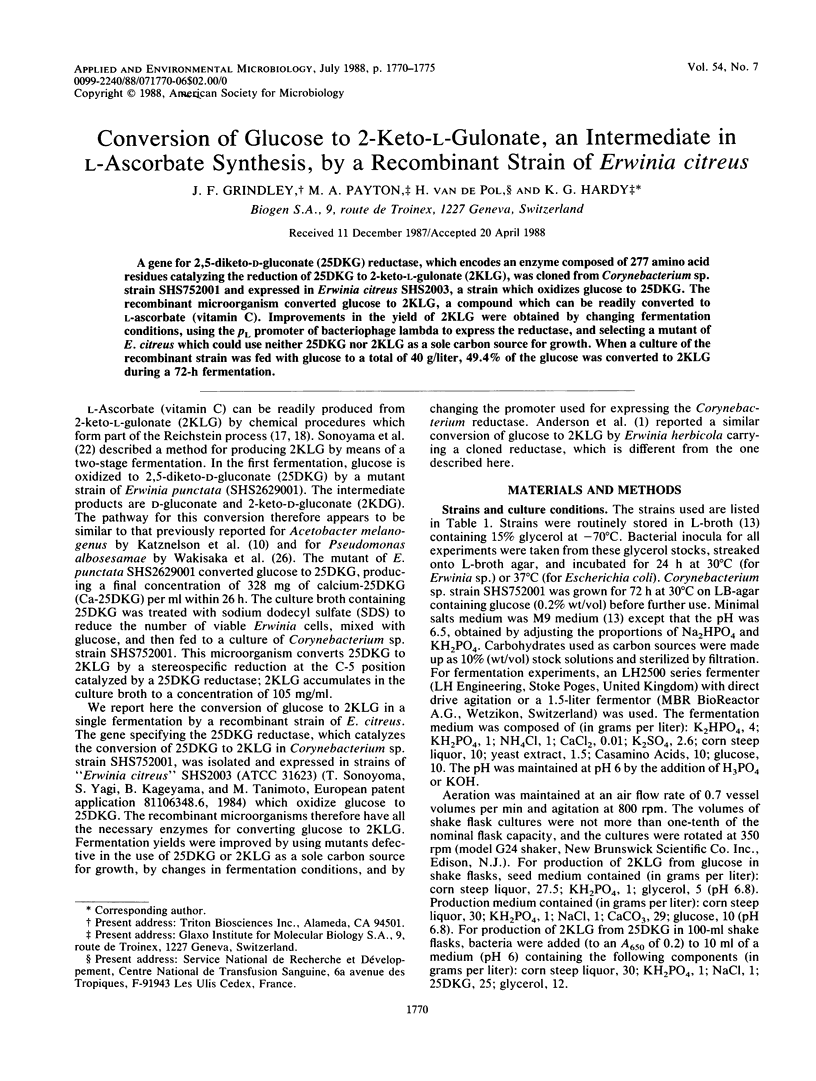
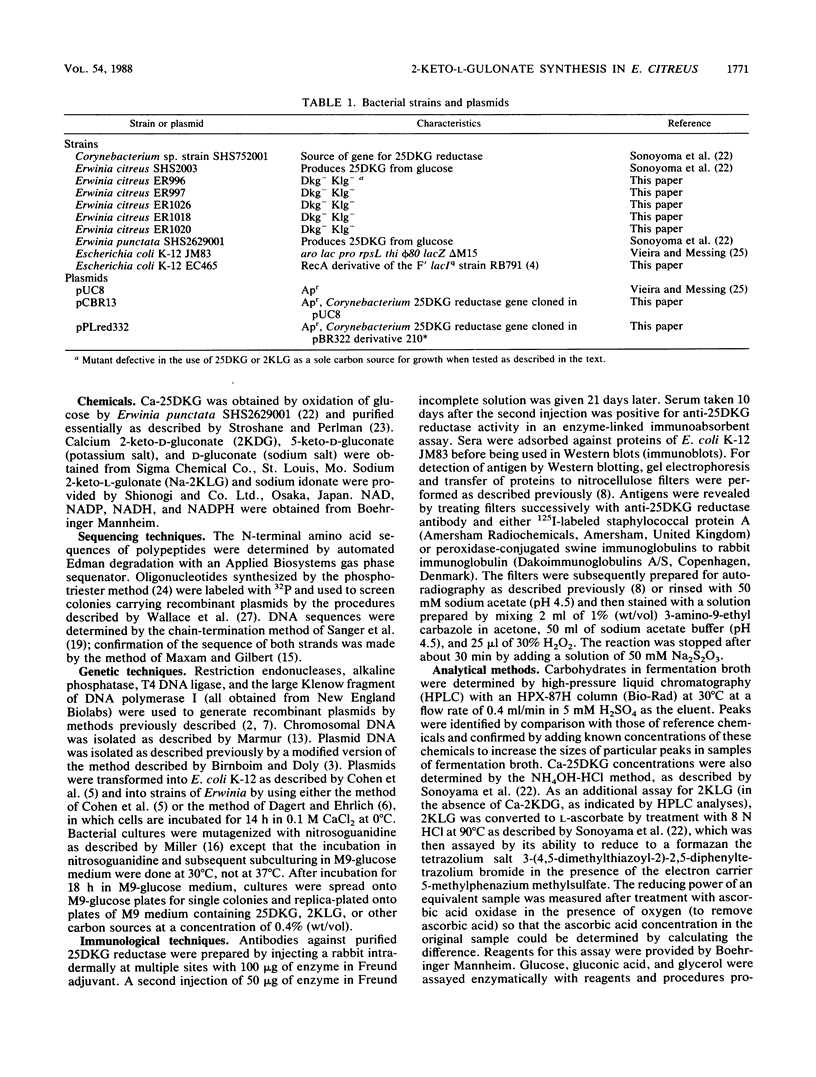
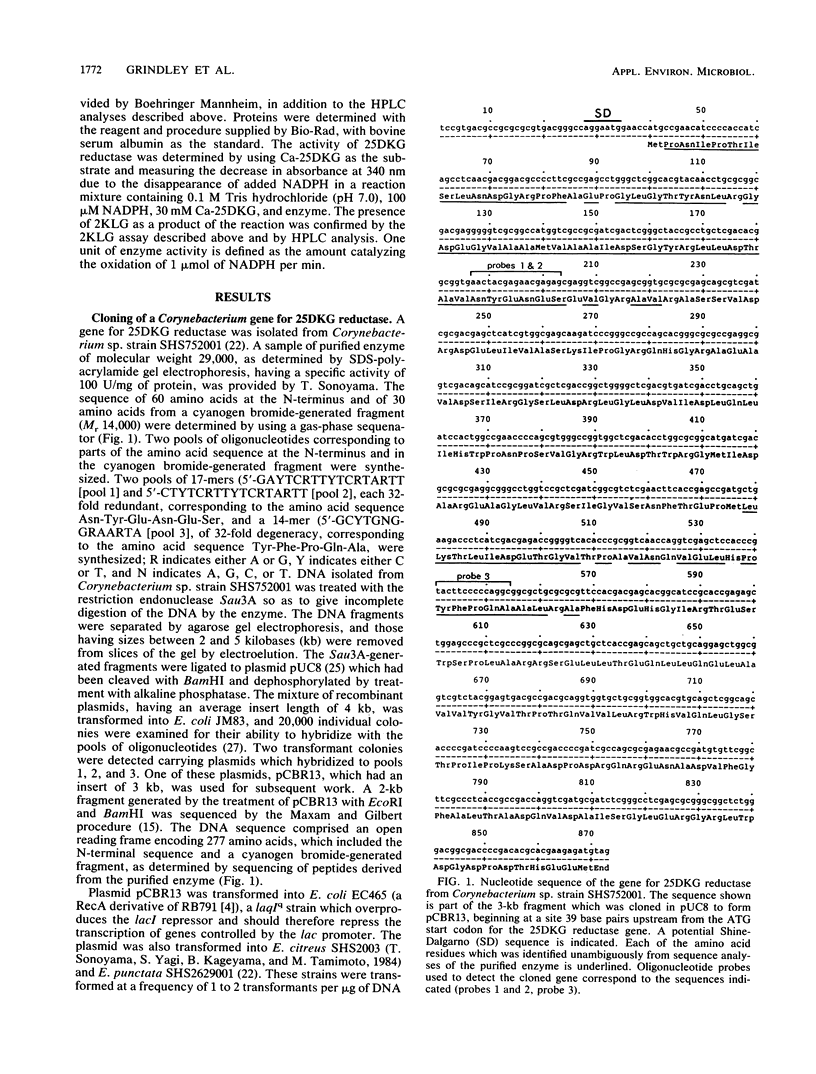
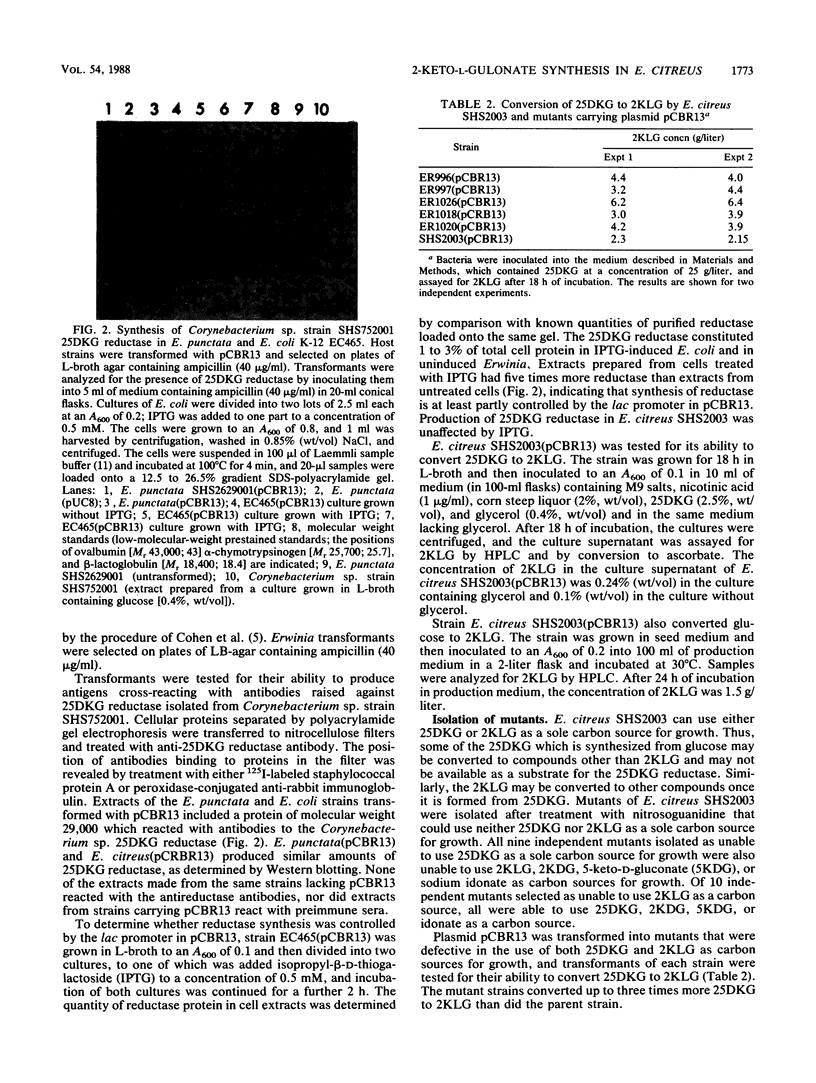
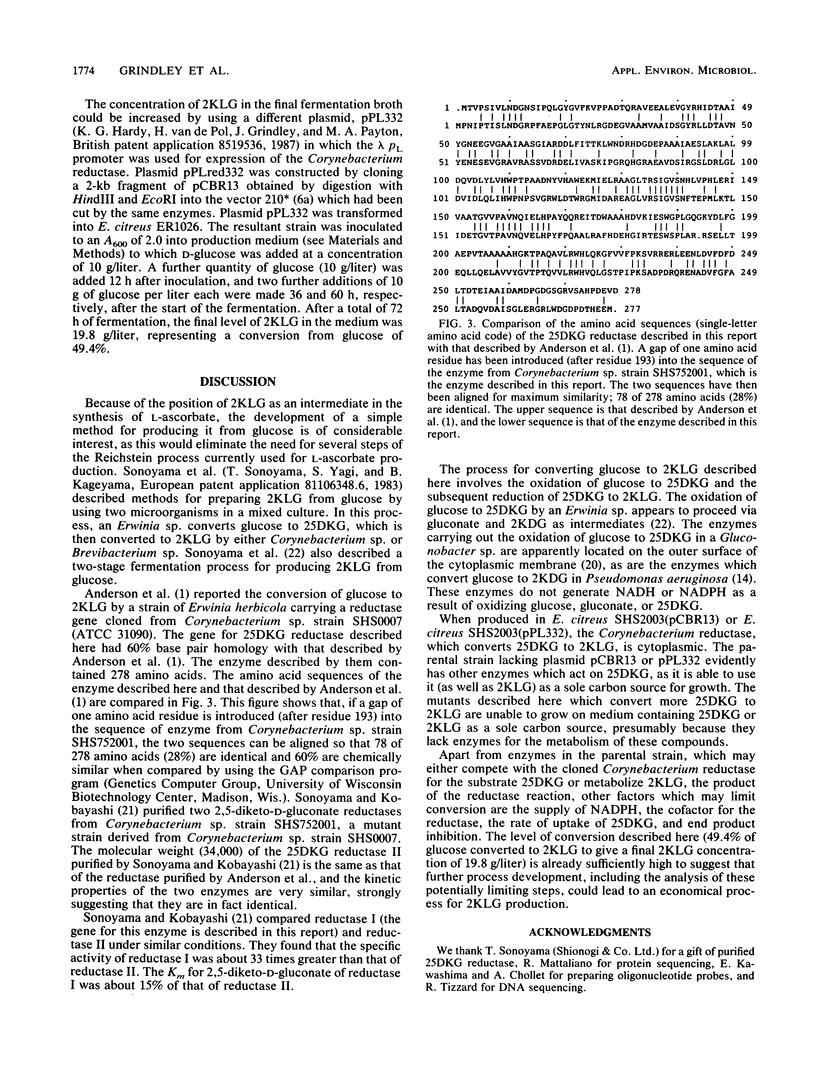
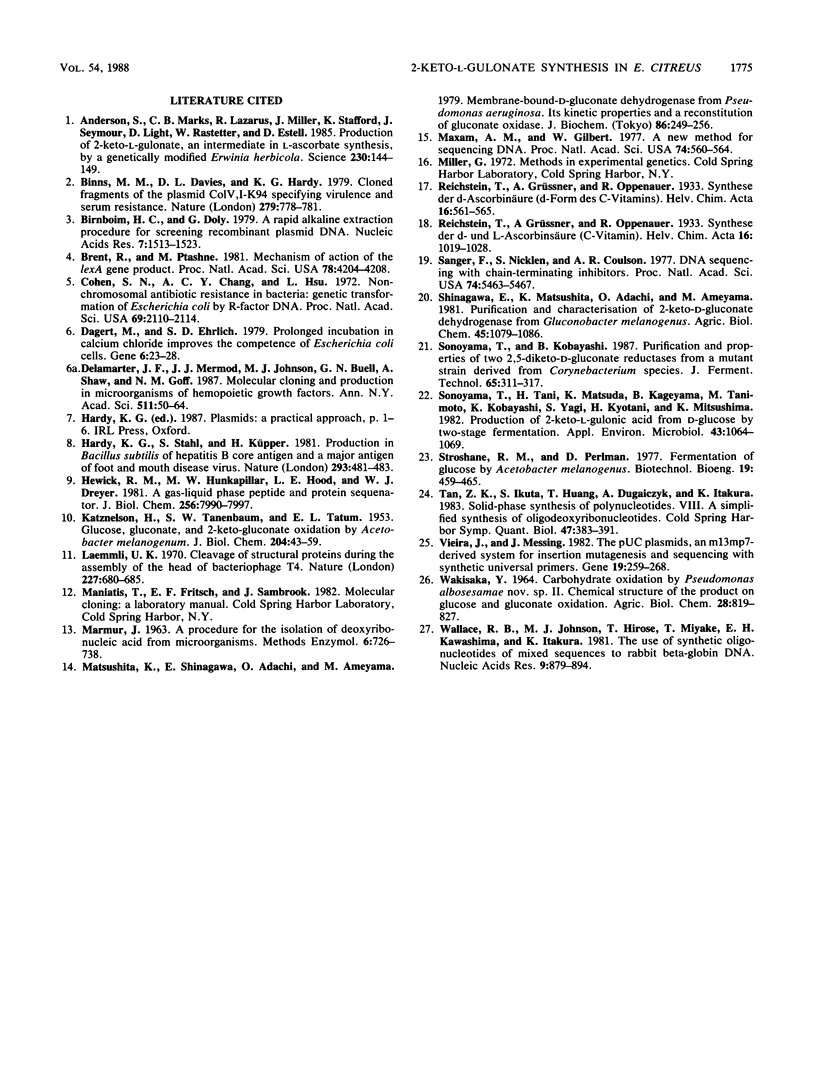
Images in this article
Selected References
These references are in PubMed. This may not be the complete list of references from this article.
- Anderson S., Marks C. B., Lazarus R., Miller J., Stafford K., Seymour J., Light D., Rastetter W., Estell D. Production of 2-Keto-L-Gulonate, an Intermediate in L-Ascorbate Synthesis, by a Genetically Modified Erwinia herbicola. Science. 1985 Oct 11;230(4722):144–149. doi: 10.1126/science.230.4722.144. [DOI] [PubMed] [Google Scholar]
- Binns M. M., Davies D. L., Hardy K. G. Cloned fragments of the plasmid ColV,I-K94 specifying virulence and serum resistance. Nature. 1979 Jun 28;279(5716):778–781. doi: 10.1038/279778a0. [DOI] [PubMed] [Google Scholar]
- Birnboim H. C., Doly J. A rapid alkaline extraction procedure for screening recombinant plasmid DNA. Nucleic Acids Res. 1979 Nov 24;7(6):1513–1523. doi: 10.1093/nar/7.6.1513. [DOI] [PMC free article] [PubMed] [Google Scholar]
- Brent R., Ptashne M. Mechanism of action of the lexA gene product. Proc Natl Acad Sci U S A. 1981 Jul;78(7):4204–4208. doi: 10.1073/pnas.78.7.4204. [DOI] [PMC free article] [PubMed] [Google Scholar]
- Cohen S. N., Chang A. C., Hsu L. Nonchromosomal antibiotic resistance in bacteria: genetic transformation of Escherichia coli by R-factor DNA. Proc Natl Acad Sci U S A. 1972 Aug;69(8):2110–2114. doi: 10.1073/pnas.69.8.2110. [DOI] [PMC free article] [PubMed] [Google Scholar]
- Dagert M., Ehrlich S. D. Prolonged incubation in calcium chloride improves the competence of Escherichia coli cells. Gene. 1979 May;6(1):23–28. doi: 10.1016/0378-1119(79)90082-9. [DOI] [PubMed] [Google Scholar]
- Delamarter J. F., Mermod J. J., Johnson M. J., Buell G. N., Shaw A., Gough N. M. Molecular cloning and production in microorganisms of hemopoietic growth factors. Ann N Y Acad Sci. 1987;511:50–64. doi: 10.1111/j.1749-6632.1987.tb36237.x. [DOI] [PubMed] [Google Scholar]
- Hardy K., Stahl S., Küpper H. Production in B. subtilis of hepatitis B core antigen and a major antigen of foot and mouth disease virus. Nature. 1981 Oct 8;293(5832):481–483. doi: 10.1038/293481a0. [DOI] [PubMed] [Google Scholar]
- Hewick R. M., Hunkapiller M. W., Hood L. E., Dreyer W. J. A gas-liquid solid phase peptide and protein sequenator. J Biol Chem. 1981 Aug 10;256(15):7990–7997. [PubMed] [Google Scholar]
- KATZNELSON H., TANENBAUM S. W., TATUM E. L. Glucose, gluconate, and 2-ketogluconate oxidation by Acetobacter melanogenum. J Biol Chem. 1953 Sep;204(1):43–59. [PubMed] [Google Scholar]
- Laemmli U. K. Cleavage of structural proteins during the assembly of the head of bacteriophage T4. Nature. 1970 Aug 15;227(5259):680–685. doi: 10.1038/227680a0. [DOI] [PubMed] [Google Scholar]
- Matsushita K., Shinagawa E., Adachi O., Ameyama M. Membrane-bound D-gluconate dehydrogenase from Pseudomonas aeruginosa. Its kinetic properties and a reconstitution of gluconate oxidase. J Biochem. 1979 Jul;86(1):249–256. [PubMed] [Google Scholar]
- Maxam A. M., Gilbert W. A new method for sequencing DNA. Proc Natl Acad Sci U S A. 1977 Feb;74(2):560–564. doi: 10.1073/pnas.74.2.560. [DOI] [PMC free article] [PubMed] [Google Scholar]
- Sanger F., Nicklen S., Coulson A. R. DNA sequencing with chain-terminating inhibitors. Proc Natl Acad Sci U S A. 1977 Dec;74(12):5463–5467. doi: 10.1073/pnas.74.12.5463. [DOI] [PMC free article] [PubMed] [Google Scholar]
- Sonoyama T., Tani H., Matsuda K., Kageyama B., Tanimoto M., Kobayashi K., Yagi S., Kyotani H., Mitsushima K. Production of 2-Keto-l-Gulonic Acid from d-Glucose by Two-Stage Fermentation. Appl Environ Microbiol. 1982 May;43(5):1064–1069. doi: 10.1128/aem.43.5.1064-1069.1982. [DOI] [PMC free article] [PubMed] [Google Scholar]
- Stroshane R. M., Perlman D. Fermentation of glucose by Acetobacter melanogenus. Biotechnol Bioeng. 1977 Apr;19(4):459–465. doi: 10.1002/bit.260190403. [DOI] [PubMed] [Google Scholar]
- Tan Z. K., Ikuta S., Huang T., Dugaiczyk A., Itakura K. Solid-phase synthesis of polynucleotides. VIII: A simplified synthesis of oligodeoxyribonucleotides. Cold Spring Harb Symp Quant Biol. 1983;47(Pt 1):383–391. doi: 10.1101/sqb.1983.047.01.045. [DOI] [PubMed] [Google Scholar]
- Vieira J., Messing J. The pUC plasmids, an M13mp7-derived system for insertion mutagenesis and sequencing with synthetic universal primers. Gene. 1982 Oct;19(3):259–268. doi: 10.1016/0378-1119(82)90015-4. [DOI] [PubMed] [Google Scholar]
- Wallace R. B., Johnson M. J., Hirose T., Miyake T., Kawashima E. H., Itakura K. The use of synthetic oligonucleotides as hybridization probes. II. Hybridization of oligonucleotides of mixed sequence to rabbit beta-globin DNA. Nucleic Acids Res. 1981 Feb 25;9(4):879–894. doi: 10.1093/nar/9.4.879. [DOI] [PMC free article] [PubMed] [Google Scholar]



